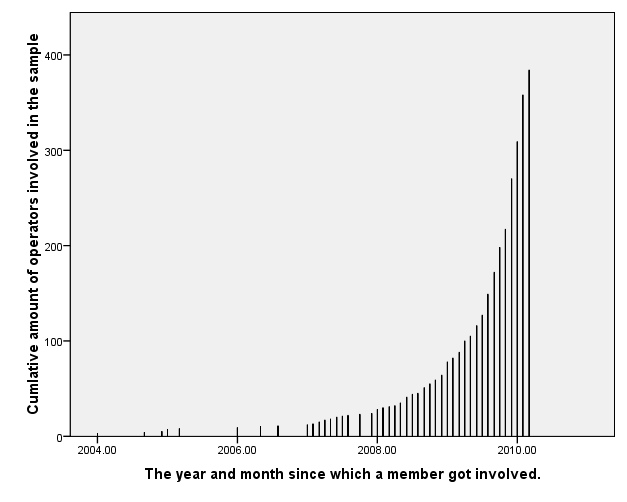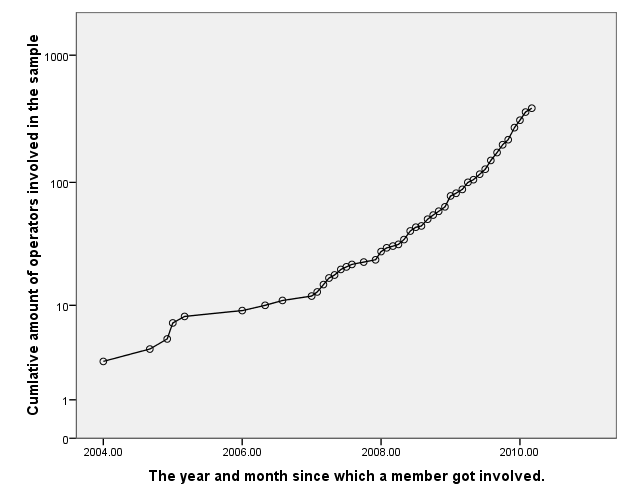Self-replicating devices: the statistics
Today was our talk on RepRap at the FAB6 conference in Amsterdam at the Royal Academy of the Arts and Sciences. Rhys Jones introduced RepRap and showed his latest developments in multiple materials. Adrian Bowyer talked about the legal implications of widespread adoption of fabrication technology. My part was about community dynamics and growth. In an earlier talk, Bre Pettis had showed, through many examples, the amazing things people are doing with 3D printers like their Makerbot and how they’re sharing them via Thingiverse. I built my talk on his great description of this open source community that innovates as a side-product of doing what they’re passionate about. Especially I first published the statistics that were based on the input from the RepRap survey which so many RepRappers had diligently contributed to.
One of the question of the RepRap survey was about when an operator had joined the community. The RepRap survey was an effort to learn about the adoption, creation and diffusion of innovations produced by user/developers. The study was done in conjunction with prof. Eric von Hippel (MIT Sloan School of Management, USA) and Jeroen de Jong (Erasmus University, EIM). The study is also a part of my master’s thesis on the viability of the open source development model for physical objects, in other words, the future of Open Source Hardware.
[Update] The slides from the presentation are available now:
OpenOffice source file: RepRap.ppt
[/update]
Disclaimer: the findings are preliminary results!
As shown in figure 1 (see below), most of the people who get involved the project and that adopt the technology have done so fairly recently. The adoption rate increases so fast that new adopters outnumber all previous adopters that had joined more than 6 months ago.
Since a significant proportion of the whole community is sampled (estimated between 10 to 20%), it is probably representative. It also hold another powerful message. An attempt to measure the size of the community is prone to be outdated when analysis of the collected data is completed. Yet, especially in the long run, the precise size is far less important than its growth rate.
What this figure also shows is that the community can attract new participants. Obviously this type of growth creates the challenge to integrate the efforts of a growing amount of individuals.


The doubling period of the amount of transistors that characterizes Moore’s law, is 2 years. Moore’s growth symbolizes one of the primary drivers of the digital revolution. It’s the reasons why today, we are all carrying phones in our pockets with the computational power and capabilities of yesterday’s PC. In a similar way, the trend towards better access to fabrication capacity is a driver for another revolution in the making: the digital fabrication revolution. With many participants that innovate 3D printing technology, 3D printers will become cheaper, more precise and introduce more capabilities like printing smart digital materials and a higher fraction of self-replication. With the technology becoming more appealing, more people will adopt them. For the open source machines, each user is also a potential developer and has an incentive to improve his machine in a way that he/she can. Solutions that are developed that can be produced with digital fabricators can easily be shared and developed collaboratively, allowing a great future for open hardware and its potential to generate civic value.
If the trend would go on uninhibited or even speed up more, it will not take long until there will be personal fabricators in most people’s homes. The tools of production are about the be democratized!
Some notes about the numbers:
- Makerbot and RapMan operators were included (many of them using these machines to make a RepRap Mendel)
- The average operator has 1.5 different types of machines. In principle people with 4 printers of the same Model will count as 1 operator.
- On the left side of the logarithmic scale the graph is easily distorted even by small variations.
- Even if the estimates are an order of magnitude too smaller in reality, I would be off only by 20 months. The correct, complete entries that were sample constitutes the absolute minimum size of the population. Even based on this estimate, extrapolating the trend for a few years it will still be a pretty significant community.
I wanted to get this information out as many people have been curious. There is more coming in the form of my master’s thesis, but I will try to add another update to my blog as well.
love the data and hope the final analasis will show what occurrances in the world caused the jumps and deviations on the graph. I would assume that make magazine having the article on reprap and tommalies in 2004-2005 was one of them, and the introduction of the makerbot another but i would like to see the various dates that important news/advertising occured overlayed on the graph.
Overlaying it would be nice, but it’s really hard not to be subjective about. What’s a major event?
The logarithmic growth will become more smooth over time since individual event will have less impact on overall growth. Or rather, they will have the same impact, but proportionally it is smaller and there are more such events. Imagine that as RepRap becomes bigger it will be in the mainstream media more frequently (something I’m experiencing myself since I’m frequently consulted for news articles).
In the beginning there are some major events that are probably identifiable though, perhaps Adrian and Vik’s first replication was visible too. Still I find the staggering duplication rate of the community the most jaw-dropping. It really illustrates how big this can become! Of course we have to keep making it easier to use along with more powerful, higher-res, etc.!
yes, the farther we get into the project the less any single event will impact, it realy is just the first couple of years that i was curious about seeing. As for the duplication rate, it is about what i would expect to see. Reprap is a singularity technology in its infancy and is likely to become ubiquitous in one form or another.
On the other hand, specific structural improvements and contributions do matter a lot, if they are consolidated and keep their effect. Also, if you affect the rate of adoption and retention (such as improvements to the code and designs, extra sets of parts printed, promoting the project) this will have a major effect in absolute numbers in the long run. It affects the steepness of the exponential curve, but will not create a dent. So a single person can have a major influence in absolute numbers.
The slides of our joint talk are now available. First up are Rhys Jones and Adrian Bowyer, the third section is my part:
RepRap @ FAB6 International Conference, AmsterdamView more presentations from Erik de Bruijn.
You can also download the original Ope
Some things are just no fun, and in a project driven by volunteers, these parts tend to be neglected. Making things user friendly doesn’t help yourself, because when you get to the point where you can improve it, the improvement is of no use to you any mo